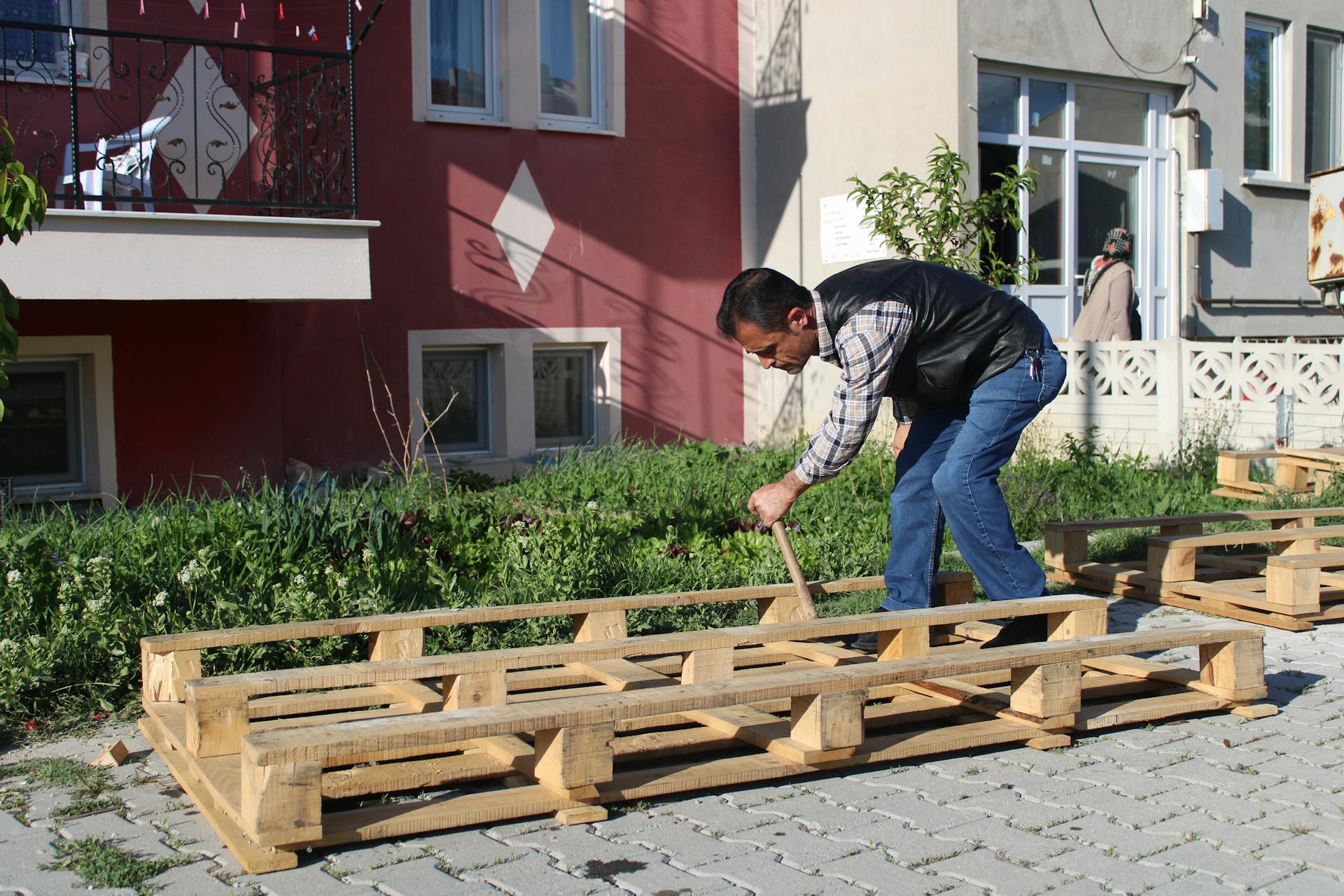
Pallets are a treasure trove of creative possibilities for your garden. You can repurpose them into functional and beautiful features that add character to your outdoor space.
Repurposed pallet planters are a great way to add some greenery to your garden, and they can be made to fit any size or style of planter you need. The pallet planters in our example use a simple design that allows for easy drainage and aeration of the soil.
By using pallets, you can create a unique and rustic look for your garden without breaking the bank. This is especially true if you're working with a limited budget or have a small garden.
Pallet Garden Ideas
Pallets can be a great low-cost solution for making a raised vegetable garden. You can create a raised bed pallet garden by using pallets to create a low-cost raised garden bed for square foot gardening.
Pallets can be repurposed to create a pathway, and using a protective sealant will provide a longer life. This is a great way to upcycle pallets and add some beauty to your garden.
Here are a few ideas to get you started:
- Reclaimed Pallet Vegetable Planter
- Create a Raised Bed Pallet Garden
- Use pallets as a pathway with a protective sealant
- Upcycle pallets into vertical planters or a mini garden shed
10 DIY Ideas
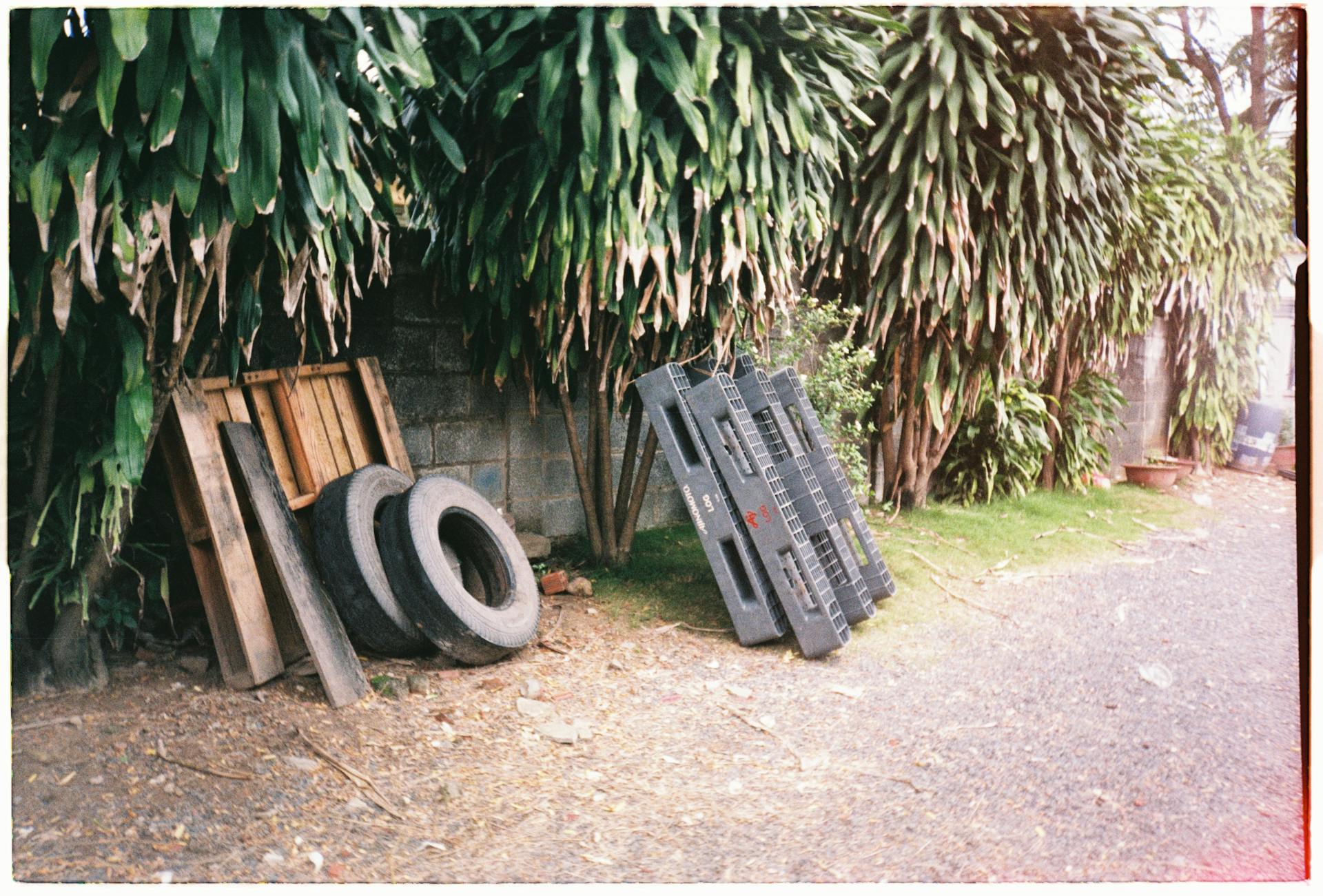
You can make a raised bed pallet garden by using individual timbers from a pallet, creating a low-cost solution for square foot gardening.
To protect the timber inside the bed, consider using a plastic liner, which will help preserve the life of the structure.
Repurposing a pallet and using individual timbers makes an easy pathway, and adding a protective sealant will provide a longer life.
A pallet planter is an eco-friendly and time-saving approach to growing flowers and vegetables side by side, cutting down on the time spent weeding and making plant identification a snap.
Wood pallet garden frames require no assembly and are readily available, often for free.
Pallets can be used as a simple painted feature fence with garden accessories, and hardwood pallets are a lot cheaper than buying timber for fence panels.
For a simple window box, dismantle your heat-treated pallets and use the wood planks individually, stacking three planks on top of each other and attaching them with a hammer and nails.
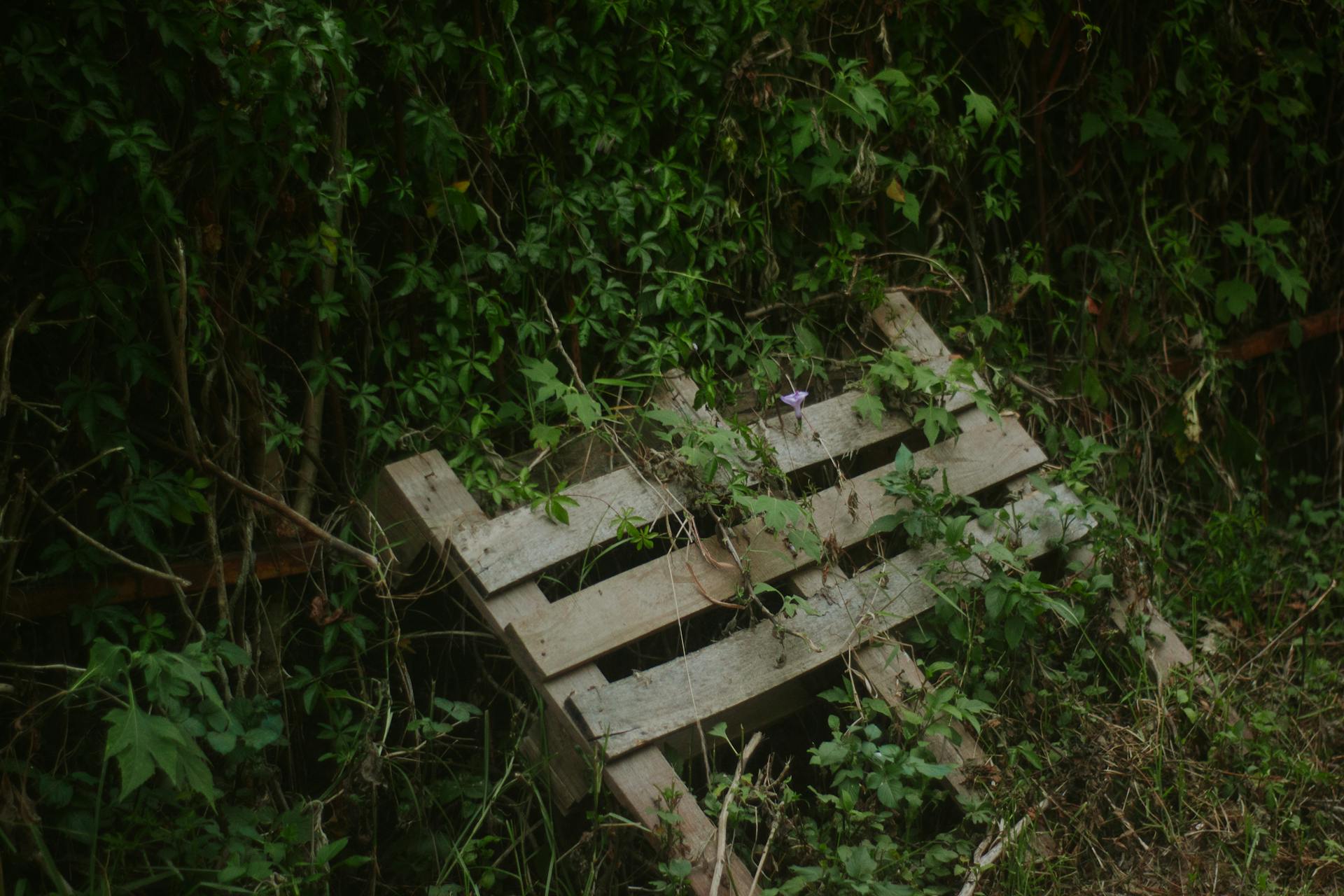
Here are some plants that will do well in a pallet raised garden bed:
- Annuals
- Lettuce
- Peppers
- Strawberries
- Herbs
- Cucumbers
Avoid plants that require a deeper root system like potatoes, carrots, and beets, and instead plant those that grow upward with a shallow root system.
A vertical pallet planter can easily be made with some basic tools and a staple gun, and landscaping fabric is best for making the pockets in order to limit weight and for accessibility considerations.
You can also use pallets to make a succulent pallet table, a DIY project that shows how good a pallet can look with a stained finish and a low-maintenance succulent centrepiece.
A pallet swing is also a great DIY project, perfect for lounging underneath a tree with a cool drink and your favorite book or magazine.
To make a pallet swing, sand two pallets and wipe them free of dust, then connect the half piece (swing back) to the full pallet (swing seat) using a drill and screws.
You can hang your swing from a strong tree branch and dress it in colorful cushions, throw pillows, and blankets.
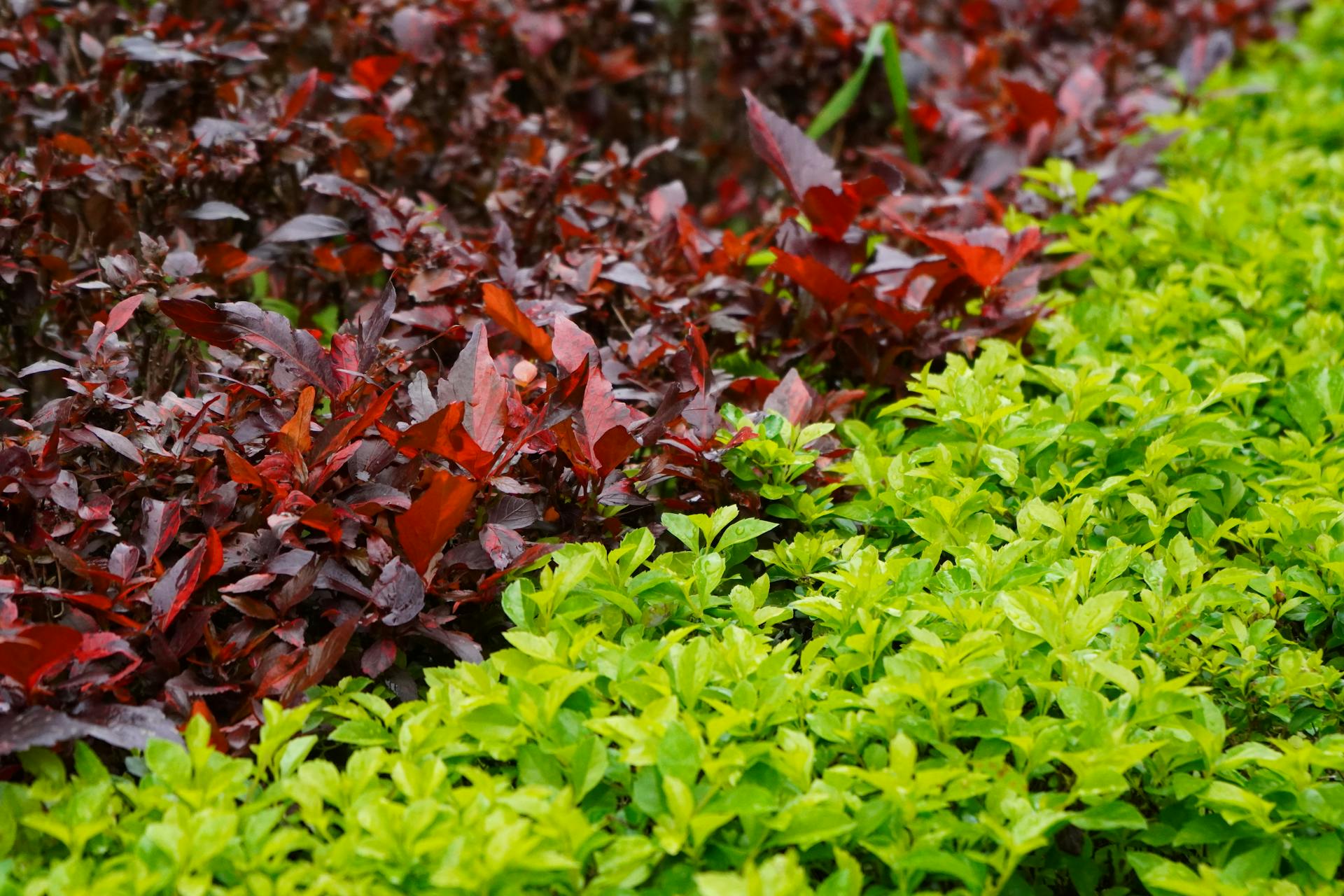
Score some free pallets at a local store, and buy an electric sander for $14 and paint for about $30 a can.
Renters and balcony gardeners should check the body corporate regulations as to what is allowed first, and remember to consider the additional weight of a vertical pallet planter too.
For Australians, check out the Recycling wood pallets and packaging brochure, which contains many tips for uses, imported and local pallet chemical treatments, and where to locate wood recycling businesses.
5. Miniature Structures
Miniature structures are a fun and creative way to repurpose pallets in your garden. You can use pallets to build small outdoor structures such as miniature greenhouses, sheds, storage boxes, compost bins, and overhead shelters.
These structures can be a great way to add some extra storage or protection to your garden, and they can be made to fit in small spaces. For example, a miniature greenhouse can be used to start seeds or harden off seedlings before transplanting them outside.
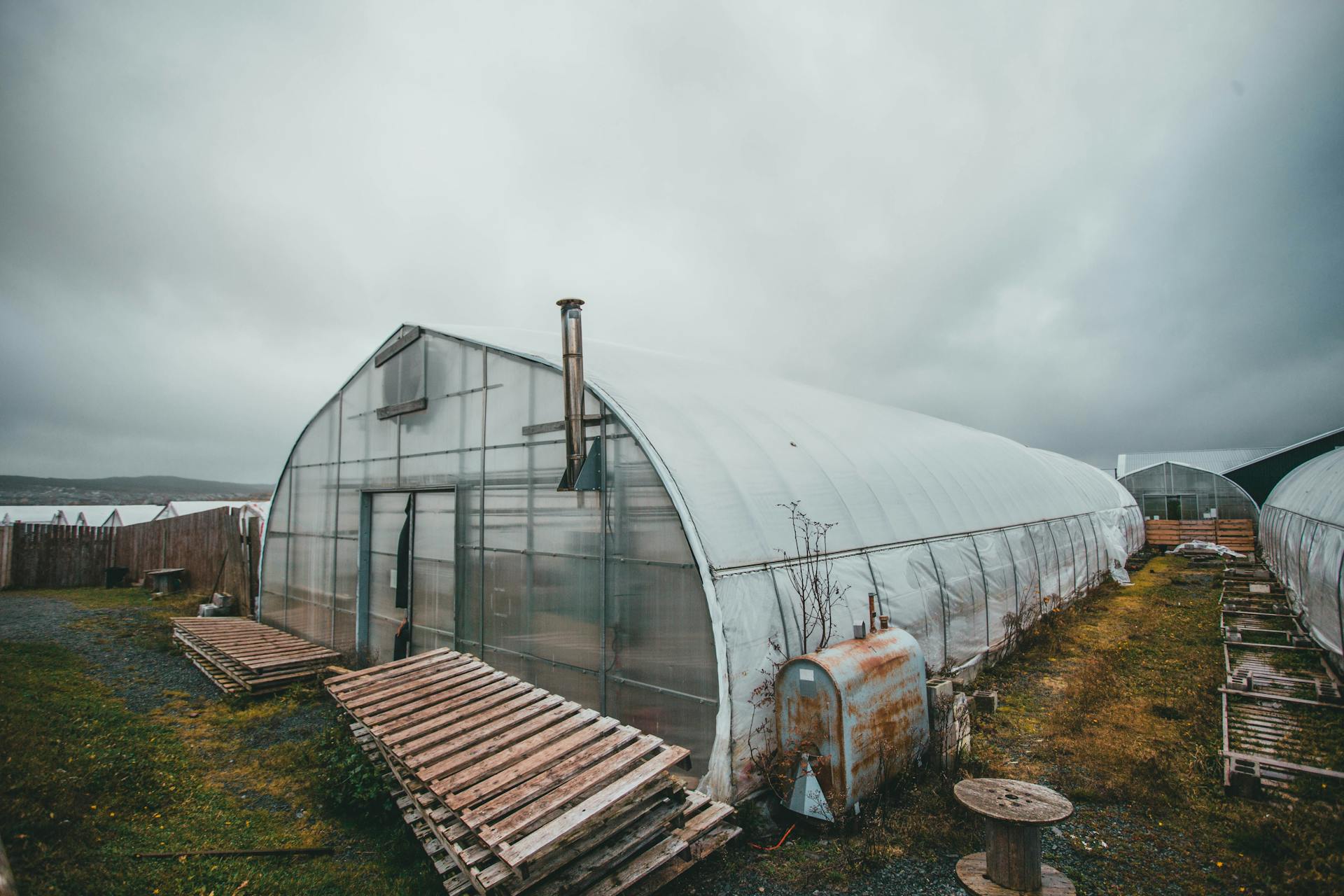
Pallets can be easily customized to fit your specific needs, and you can add features like windows, doors, and roofs to make them more functional. You can also add decorative touches like paint, stain, or other finishes to make them blend in with your garden's style.
A storage box or shed can be a great way to keep your garden tools and supplies organized, and a compost bin can help you turn kitchen scraps into nutrient-rich soil.
Pallet Garden Design
Pallet garden design is all about repurposing wood pallets into functional and space-saving planters. You can create a vertical herb garden by upcycling a pallet, which won't take up much room and can be ready to use in about an hour.
To ensure your pallet planter is safe for an edible garden, try to find out about its prior use. Some pallets may have been used to haul toxic chemicals or be infested with pests or fungi. Heat-treated pallets are generally safer than chemically treated ones.
You can stack two or three pallets together to make a taller raised garden bed, saving your back from bending and straining. The top pallet just needs to be enclosed with burlap or landscape fabric for planting.
Vertical
Vertical pallet planters are a great way to make the most of your space, and they're surprisingly easy to create. You can transform an old pallet into a planter in about an hour, and it won't take up much room.
To get started, look for a pallet that's been heat-treated, as these are typically safer for edible gardens. Some pallets may have been used to haul toxic chemicals, so it's essential to check their history before using them.
You can upcycle pallets into vertical planters by attaching landscaping fabric to the back and filling the slots with soil and your favorite plants. This will help limit weight and make it easier to access the plants.
If you want to create a taller raised garden bed, try stacking two or three pallets together. Just enclose the top pallet with burlap or landscape fabric for planting, and the others below will add height.
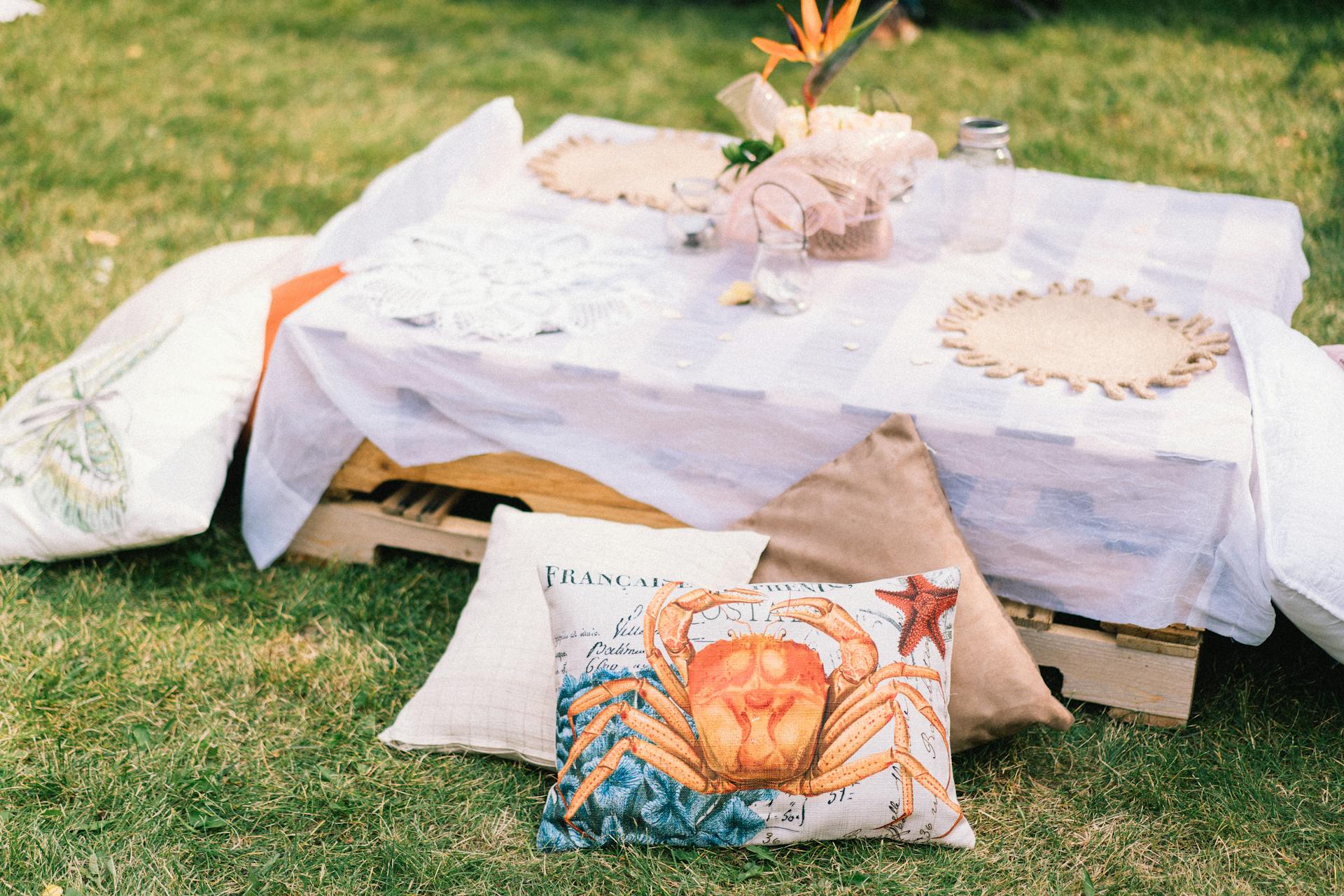
Some plants that do well in pallet raised garden beds include annuals, lettuce, peppers, strawberries, herbs, and cucumbers. These plants have shallow root systems and will thrive in a pallet planter.
Here are some plants to avoid in a pallet raised garden bed:
- Potatoes
- Carrots
- Beets
These plants require a deeper root system and may not do well in a pallet planter.
You can also use pallets to create a functional screen or hide an unsightly water tank from a kitchen window. A low-maintenance succulent pallet garden is a clever solution for this type of project.
Pallets can be used as is, given a coat of paint and hung on a wall as shelving, or dismantled and used for another project.
4. Freestanding Trellis
A freestanding trellis is a great way to add some vertical gardening to your space, and it's surprisingly easy to build. You can attach two pallets together with a hinge at the top, making it a DIY project that's accessible for people of all skill levels.
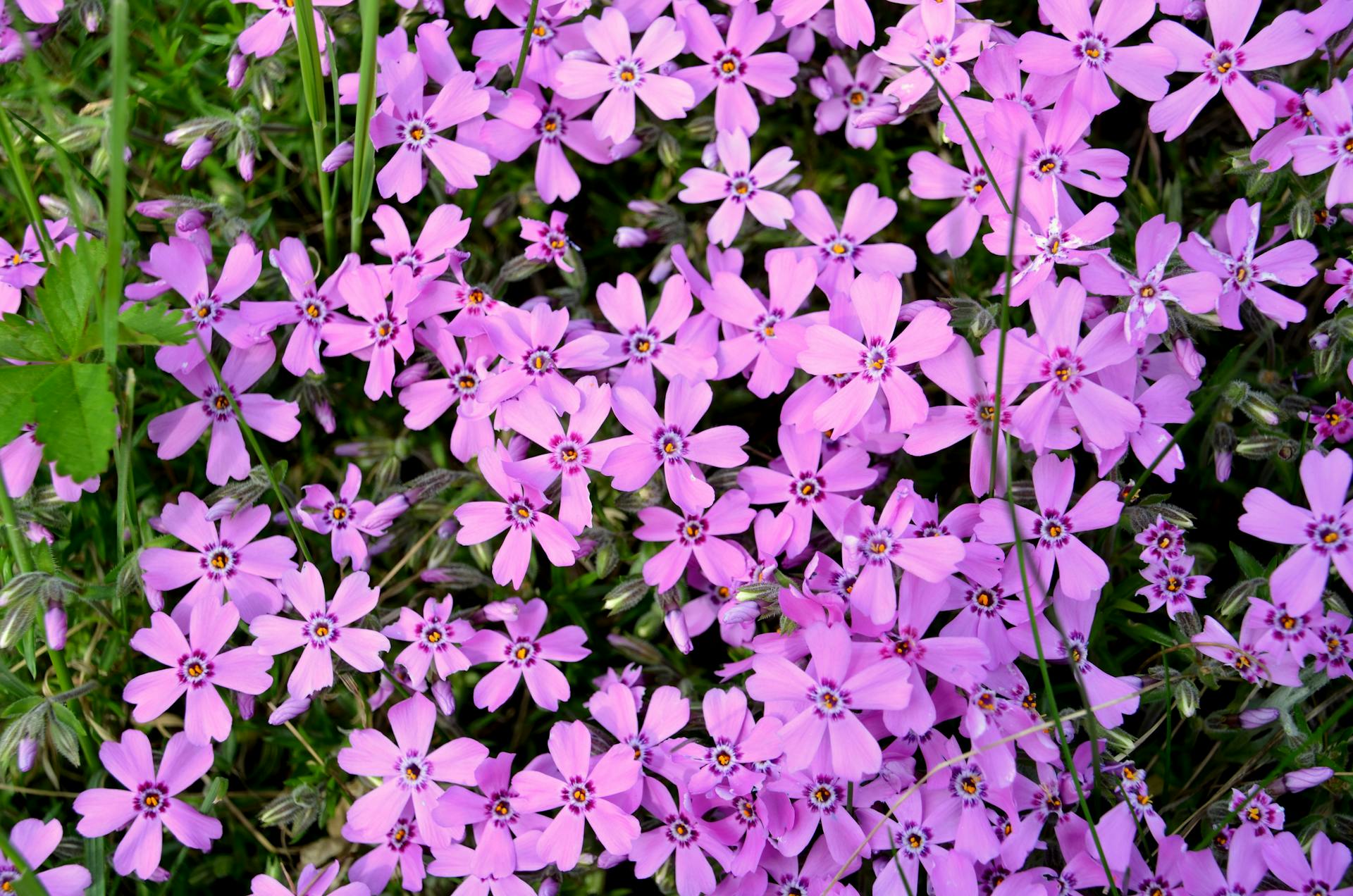
This method is also super time-efficient, allowing you to spend less time building and more time nurturing your green thumb.
The best plants to grow on a pallet trellis include vining fruits and vegetables like cucumbers, melons, pole beans, squash, tomatoes, and raspberries.
You can find free pallets at local stores, construction sites, schools, printing companies, and farmers markets, making this project essentially cost-free.
Pallet Garden Tips
To build a successful wood pallet garden, follow these tips: choose a flat and level spot in your yard to place the pallets. This will ensure your garden remains stable and easy to maintain.
Select pallets that are in good condition and free of any chemicals or pesticides, as these can harm your plants. Consider repurposing old pallets to reduce waste and give them a new life in your garden.
Consider adding a trellis or other support system to your pallet garden to help your plants grow upwards and make the most of the space.
Tips
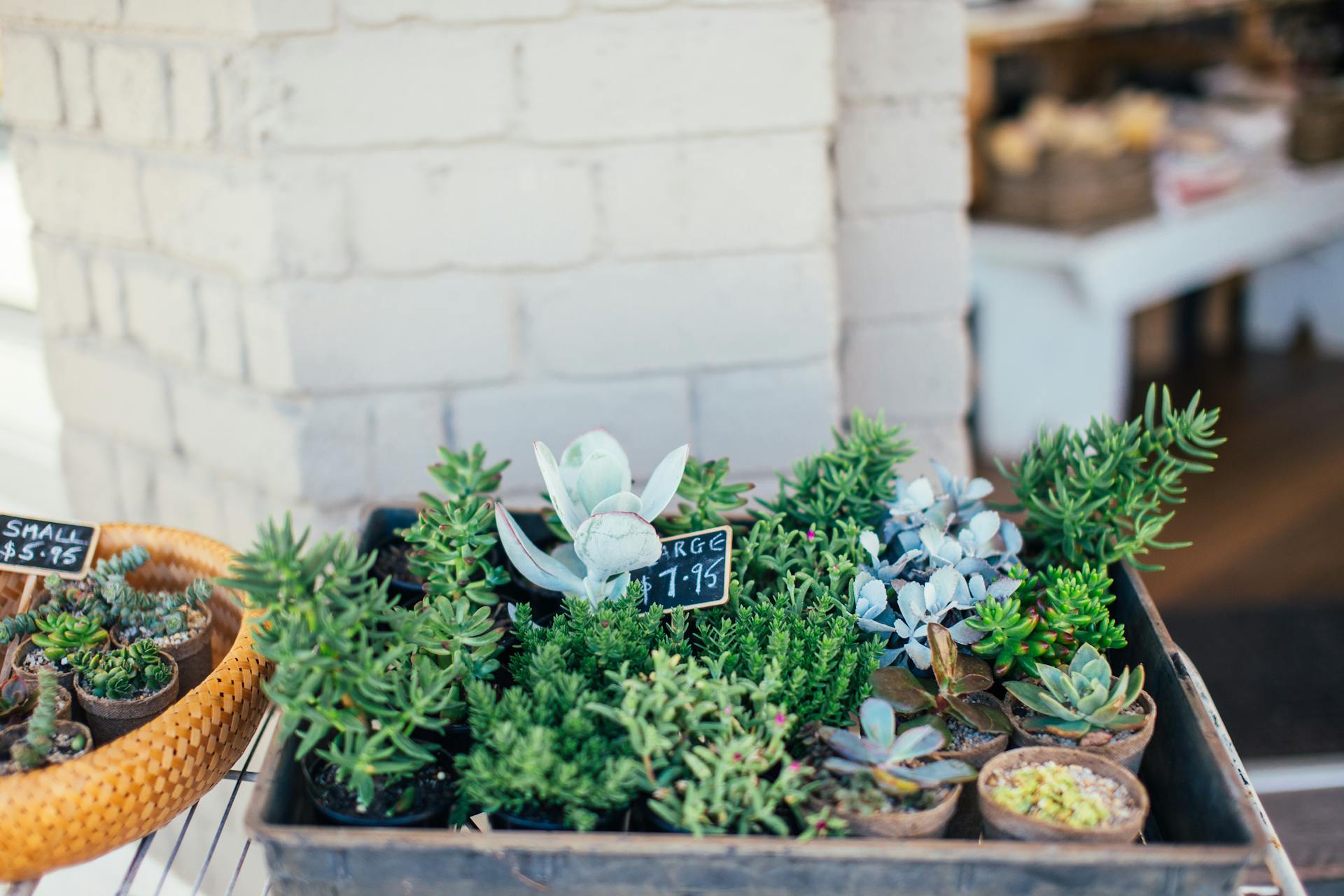
To build a successful wood pallet garden, you'll want to start by creating a portable greenhouse. This can be achieved by tucking square pots into the pallet in four 'windows', which can be useful in many situations or cut down to size and stacked vertically.
You can add panes of glass or perspex to each 'window' in the greenhouse on top of pavers as needed. This will provide the necessary protection for your plants.
To make your pallet garden pathway look funky, you can draw inspiration from Funky Junk Interiors.
Here are some key considerations for building a pallet garden:
- Make a Pallet Garden Pathway – Funky Junk Interiors
- Use square pots in the pallet's 'windows' to create a portable greenhouse.
- Add panes of glass or perspex to each 'window' on top of pavers as needed.
Item Safety Verification
Before using a pallet in your garden, it's essential to verify its safety. Check the markings on your pallet, as they can reveal crucial information about its treatment.
HT (heat-treated) pallets are generally safe for use in edible gardens. Methyl bromide, however, is a highly toxic chemical that should be avoided.
Heat-treated pallets are considered safe because they're treated to kill insects and other pests without using toxic chemicals. This makes them a great option for gardeners who want to avoid potential hazards.
Tips for Upcycling

SAFETY FIRST! If you intend growing edibles in your pallet garden, do your due diligence first. You can use pallets as support structures rather than planting directly into them. No VOC or eco-friendly preserving treatments may also be an option. Remember to use PPE (personal protective equipment) such as gloves and a mask when handling or cutting timber.
To ensure you're using safe pallets, look for the ISPM-15 mark, which is now very commonly seen on wood packaging in Australia including pallets. The mark may include additional information, such as DB for debarked, KD for kiln-dried, DUN for dunnage, or the packaging manufacturer’s name.
Heat treated (HT) marked hardwood pallets are safer to use than those that have been fumigated and marked chemically treated (CT) or pressure treated. This is especially important if you're planning to use your pallet garden for growing edibles.
Here are some key differences between safe and unsafe pallets:
By following these safety tips and choosing the right pallets, you can create a beautiful and functional pallet garden that's perfect for growing your favorite plants.
Watering and Growing Tips
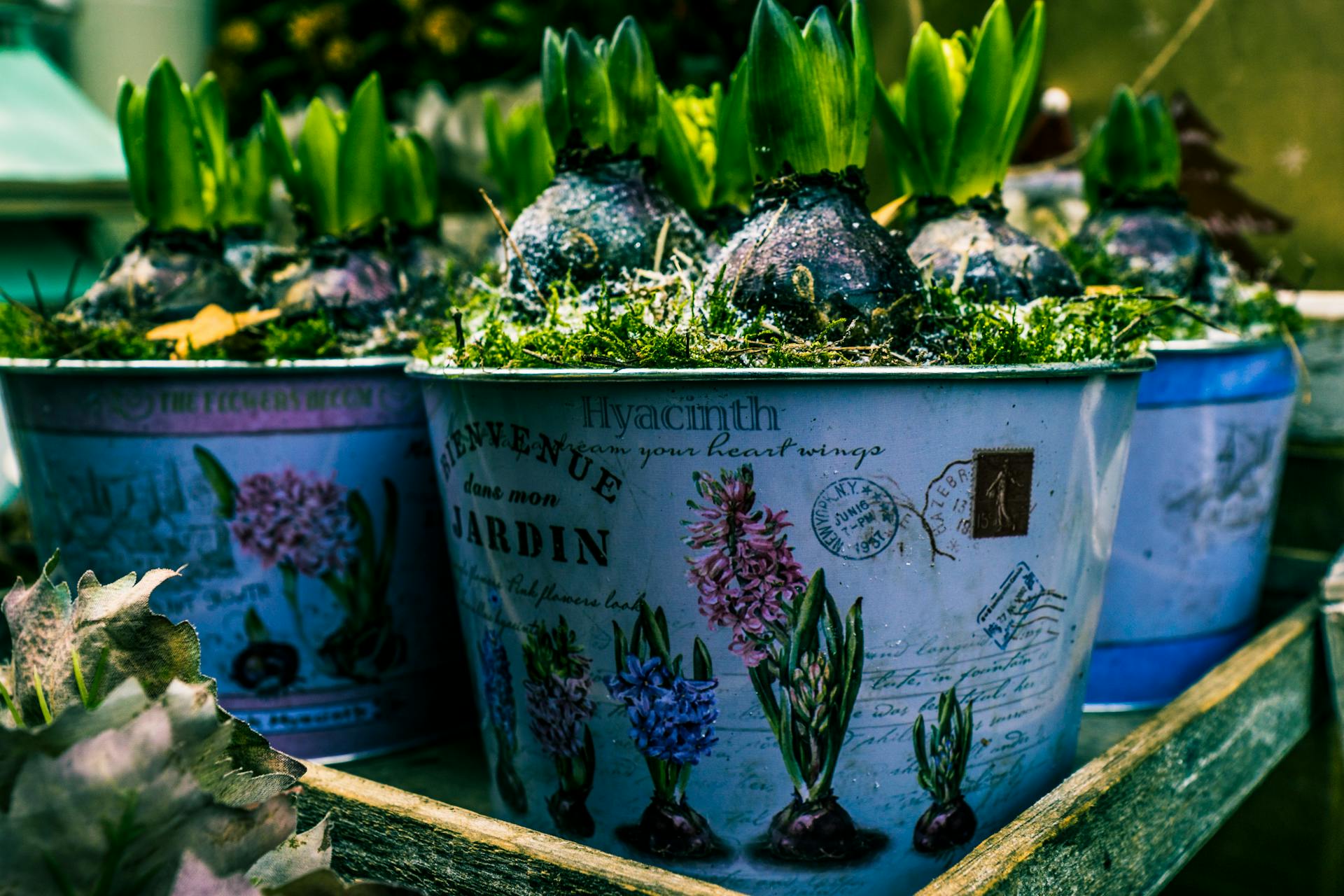
Watering a pallet garden can be a challenge, but there are some simple solutions to make it easier. Consider installing a drip irrigation system to save time on hand watering.
The bottom two rows of a vertical pallet garden will be the driest, so choose plants with low water requirements like succulents or use a quality potting mix rich in nutrients and moisture holding capacity.
To keep your plants happy, add a potting mix that won't dry out too quickly. Bagged soil mixes can be a problem, but making your own potting mix can give you peace of mind.
Here are some key things to consider when watering your pallet garden:
- Check the soil regularly, as plants in planters need more frequent watering.
- Use a quality potting mix to help retain moisture.
- Choose plants that are adapted to dry conditions, like succulents.
If you're looking for a low-maintenance option, consider using perennials like rocket (arugula) and chives, which will need replacing less often.
Pallet Garden Benefits
Using pallets for your garden is a great idea, and one of the main benefits is that it's easy to build them - just lay them out on the ground and add soil, compost and plants.
Raised beds made from pallets are perfect for keeping your garden neat and tidy.
Pallet Garden Construction
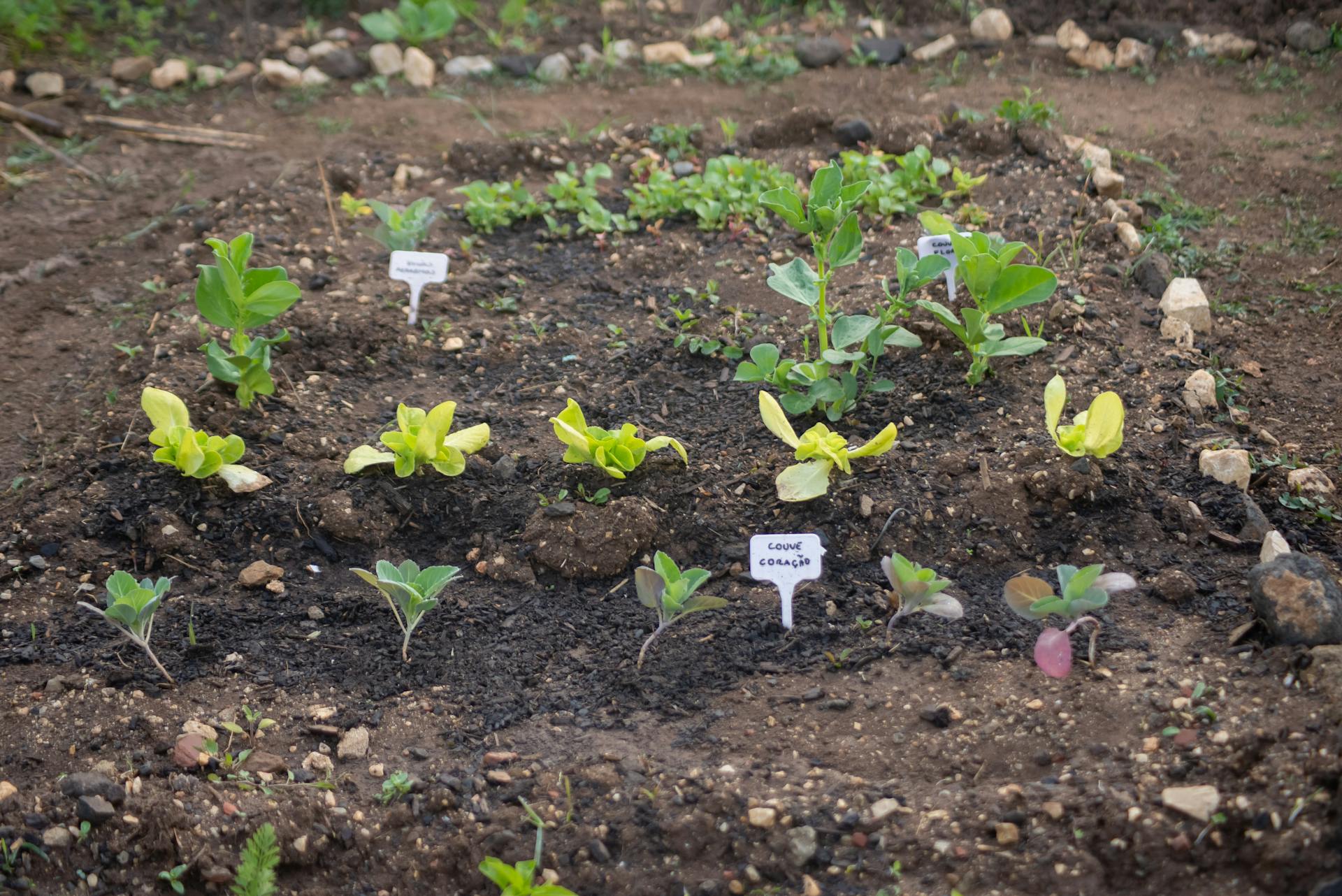
Pallet garden construction is all about getting creative with materials you might otherwise throw away. Upcycling is the process of converting waste materials into new products of better quality or higher environmental value, and pallets are a great starting point.
You can turn a pallet into a stunning vertical garden, perfect for a narrow balcony or limited space, by repeating coordinated colors and following the DIY instructions. This idea can also be adapted for use as a privacy screen, wall art, herb planters, or just a decorative feature.
Pallets make great low-cost compost bays, and you can even add a hinged gate or a simple 4-pallet compost system to make it more functional. Here are some ideas for pallet garden construction:
- Compost Bin with a Hinged Gate
- 4 Pallet Compost System
- Vertical Pallet Garden
- Privacy Screen
- Wall Art
- Herb Planters
Raised
Building a raised garden bed using pallets is a fantastic way to create a unique and accessible space for your plants. You can literally elevate your flower beds and vegetable gardens to above ground level, making it a more comfortable experience for you.
To start, you'll need to gather some materials, including a hammer, nails, a hand saw, and two heat-treated pallets per raised bed. If you're a DIY newbie, don't worry – there are plenty of simple tutorials available, like the one mentioned in Example 1.
A raised bed pallet garden will not only elevate your plants, but also your style and accessibility. You can grow just about anything in a raised bed, from succulents to salad greens, pansies, hostas, and lemongrass.
To prevent weeds and pests, lay landscape fabric on the bottom of your raised beds, and cover it with potting soil. This will create a nutrient-rich growing medium for your plants.
Here are some examples of plants that can thrive in a raised bed:
- Succulents
- Salad greens
- Pansies
- Hostas
- Lemongrass
You can find pallets for free by visiting local businesses and asking if they have any they're willing to give away. Alternatively, you can buy a pack of 10 recycled pallets for about $14 each online. This will cost you around $30, plus the cost of any additional tools you might need.
How to Create
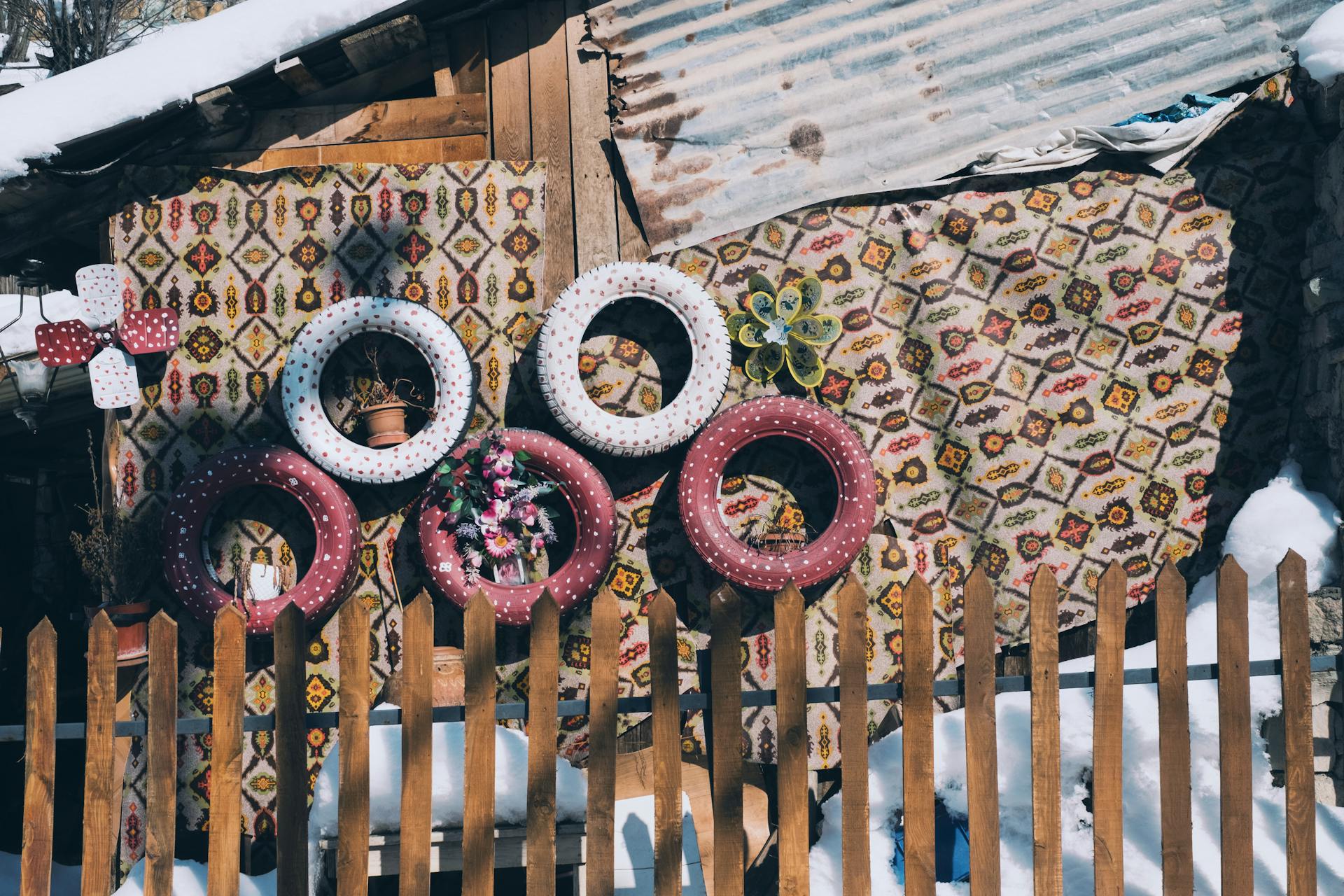
To create a pallet garden, you'll need to start with a few basic steps. First, acquire some pallets and ensure they're not treated with chemicals.
Enclosing the bottom and sides of the pallet is a crucial step. This can be done by stapling a double layer of burlap or landscape fabric to prevent soil from falling through. This simple trick will keep your soil in place and make maintenance a breeze.
Next, add some nutrient-rich soil and compost to your pallet garden. This will give your plants the best chance to thrive. You can also reuse materials like old pallets to create a mini garden shed, like I did for $7.
Now that you've got your soil and compost in place, it's time to add your desired plants. Water them in and watch your garden grow! Upcycling pallets is a great way to reuse materials and reduce waste.
Here are some creative ideas to get you started:
Remember, upcycling is all about converting waste materials into something of better quality or higher environmental value. With a little creativity, you can turn an old pallet into a beautiful and functional garden feature.
Pallet Garden Accessories

Pallet garden accessories can greatly enhance your outdoor space and make the most of your pallet garden.
A trellis made from pallet wood can provide a beautiful support system for climbing plants like peas and beans.
Pallet planters are a great way to add some extra greenery to your garden, and they can be made in various sizes to suit your needs.
You can also use pallets to create a DIY compost bin, which will help you turn food waste into nutrient-rich soil for your plants.
Some pallet garden accessories, like pallet shelves, can be used to store gardening tools and supplies, keeping them within easy reach.
A pallet garden bench can provide a comfortable seating area where you can relax and enjoy your garden.
Frequently Asked Questions
How do you know if a pallet is safe for gardening?
Check for an 'HT' mark on the pallet's side to ensure it's been heat treated and safe for gardening use
How long do pallet gardens last?
Pallet gardens can last up to 3 years with proper sealing and maintenance. With proper care, they can provide a long-lasting and sustainable gardening solution.
Can I use old pallets for raised garden beds?
Yes, you can repurpose old pallets for raised garden beds, but make sure they're heat-treated and free from chemicals. With some preparation, such as sanding rough edges and securing the structure, you can create a unique and eco-friendly garden bed.
How to use pallets for vegetable garden?
To create a vegetable garden using a pallet, lay it flat and fill it with potting soil through the slats, packing it firmly in each layer. Start planting from the bottom up, leaving enough space for your vegetables to grow.
What to line a pallet planter with?
For pallet planters, consider lining with heavy-duty plastic or hanging pot liner rolls, depending on the type of wood used (hardwood or softwood). This protective layer helps extend the planter's lifespan and prevent damage.
Sources
- https://www.thespruce.com/wood-pallet-ideas-for-gardens-4172915
- https://www.lawnstarter.com/blog/landscaping/pallet-garden-ideas/
- https://www.rainchainsdirect.com/pages/5-creative-ways-to-reuse-pallets-in-your-garden
- https://www.gardengatemagazine.com/articles/diy-projects/upcycling-projects/diy-pallet-raised-garden-bed/
- https://themicrogardener.com/20-creative-ways-to-upcycle-pallets-in-your-garden/
Featured Images: pexels.com
